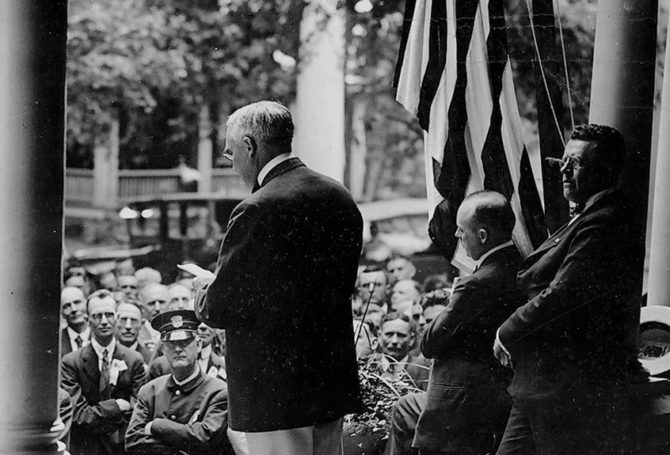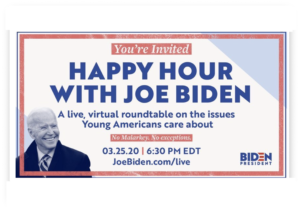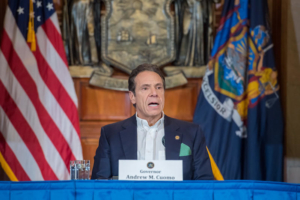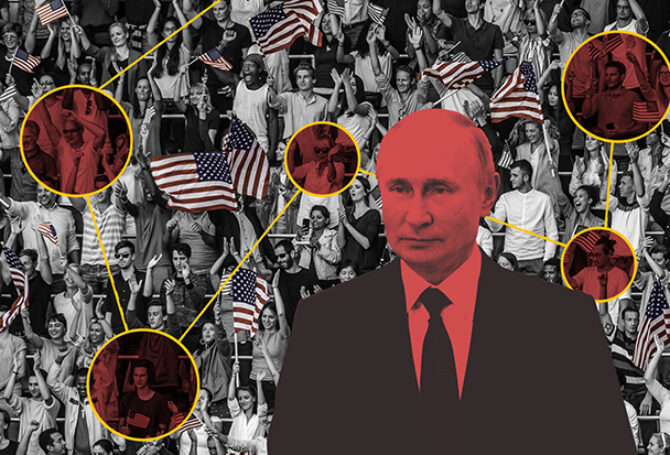
Once upon a time in America, candidates for president “campaigned” from their front porch. The coronavirus may revive those presidential front-porch campaigns with some modern twists.
Until the 20th century, US presidential candidates, with the exception of Andrew Jackson, feigned a public disinterest in the job, letting their supporters do the dirty work of campaigning. The advent of radio and later television changed things, as candidates began giving speeches, holding political rallies and stumping on the rear platforms of railroad cars. The internet and social media made presidential hopefuls and their fundraising requests even more ubiquitous.

Current expectations are for presidential candidates to appear everywhere – state fairs, townhalls and selfie lines. Pressing the flesh, kissing babies and directly answering voter questions has become de rigueur for presidential campaigning. At least until the coronavirus outbreak, social distancing and shelter-in-place orders.
Joe Biden and Bernie Sanders, the two remaining Democratic presidential hopefuls, have canceled political rallies and in-person fundraisers for the foreseeable future. President Trump hasn’t pledged to stay off the stump, but he hasn’t held any rallies in the last two weeks, except defacto ones in the guise of daily coronavirus briefings. The stage is set for a front-porch campaign – where the front porch is video conferencing, social media and tweets.
Unlike their early-America forebears who maintained a “dignified silence,” 2020 presidential candidates won’t hesitate to toot their own horns. But that can wear thin in a virtual environment where viewers simply tap to go to another site. The good news is people forced to stay home have time on their hands and a willingness to engage online. The bad news is that the current band of candidates are stuck using engagement techniques of yesteryear. It’s like Vanna White on “Wheel of Fortune” still turning manual letters or Richard Nixon refusing makeup to hide his five-o’clock shadow when he debated John Kennedy.

The political figure getting widespread accolades for his online leadership is New York Governor Andrew Cuomo. “Cuomo has been blunt and at times searching, but unerringly forthright, even with unnerving information,” CNN writes. “He has been open in seeking out the equipment desperately needed by health care providers, like face masks and ventilators. Asked on Friday if the state was headed toward a cash crunch, he answered, ‘Yes.’ When discussing his statewide order requiring workers in nonessential businesses to stay home, Cuomo acknowledged the potential for criticism.”
Cuomo has not shied away from taking responsibility, including his order to close down businesses and shelter in place. “If someone is unhappy, if somebody wants to blame someone or complain about someone, blame me. There is no one else who is responsible for this decision.” He offers a sense of realistic hope that his state and the country will get through the crisis.
His brand of steady fact-telling, responsibility-accepting and no-sugarcoating hits the mark with a population that rightfully can be described as fearful and unsure what’s next in terms of public health and the economy. And Cuomo is doing it behind a microphone without a crowd in the epicenter of the US coronavirus outbreak.
Trump has drawn mixed reviews for his daily coronavirus briefings that lurch between information dissemination and personal politicking, which appeals to his base and repels his detractors. At best, the briefings dispatch confusing signals – sometimes at the same briefing.
Biden has begun a series of video “appearances” that have been more measured, but not exactly emotion-tugging or attention-grabbing online moments.
Vice President Mike Pence, who was assigned to lead the Trump administration coronavirus task force, had displayed more discipline in delivering daily updates, but has coated most of his statements with obsequious tributes to Trump who looms in the background, eager to lunge back to the podium to duke it out with the White House press corps.
After Biden’s presumptive Democratic presidential nomination, he will name a vice presidential running mate who will join the online chorus of political voices, assuming large rallies and state-hopping are still no-goes deep into the election season. Biden has pledged to name a woman, who also will be judged on her online presence and capabilities. It’s likely Biden will weigh his choice with this dimension playing a larger role than ever before.
The 21st century front-porch campaign will provide a dramatically new test of presidential leadership – coolness. As Marshall McLuhan explained in a pre-social media era, cool media are ones that require viewer engagement. McLuhan associated different media with parts of the human body. Books are extensions of the eye. Movies are extensions of eyes and ears. McLuhan might have associated social media as an extension of the eye, the ear and the human desire to connect. That will be the challenge for presidential and vice presidential candidates in the 2020 election.
Trump’s pattern for in-your-face engagement is unlikely to change. Pence’s more reserved, subservient manner seems permanent, too. The hole card is how Biden will adapt his on-stage online demeanor that is often uneven. His campaign went on a spectacular upswing after he followed the advice of South Carolina Congressman Jim Clyburn to show more emotion. However, emotional displays drift into the space of hot media, where viewers watch more than engage.
Running for president is a daunting exercise under normal times (whatever that is). The pandemic-caused fear and economic collapse that grip the nation makes presidential outreach even more challenging as candidates have to move their front porches metaphorically to a room with good lighting and an internet connection. What they do – and how well they do it – in front of a computer or iPhone camera may decide who wins the confidence of the country.
A Relevant Lesson from the Fateful 1860 Lincoln Presidential Campaign
Abraham Lincoln didn’t exactly campaign for president from his front porch, but he did employ a cool-media tactic that captured public attention and boosted him from obscurity to the White House.
Lincoln contrived to publish his debates with Stephen A. Douglas, which didn’t win him a Senate seat, but did catch the eye of Republican leaders. The attention led to an invitation to speak at Cooper Union in New York. His remarkable, carefully phrased and well-reasoned speech catapulted Lincoln into the Republican spotlight.
A quickly assembled trip throughout the Northeast at which Lincoln gave the stump version of his famous Cooper Union speech in 11 cities cemented his reputation and ultimately earned him the Republican nomination and the presidency.
Lincoln did in his day what 2020 presidential candidates must do in theirs – find a way to get noticed and exploit that opportunity as much as possible. Lincoln won without pressing the flesh and kissing babies. He won by wit, showing how the nation could address the biggest crisis of his time – the expansion of slavery into western states.
This year, Trump as the incumbent will be judged on his performance in addressing the coronavirus outbreak and its aftermath. Biden as the presumptive Democratic presidential challenger, will be judged on whether he can return the nation to post-pandemic prosperity that spreads to middle-income, working-class families. Voter judgments will be based largely on what they see and hear from the candidates in their own front rooms.



